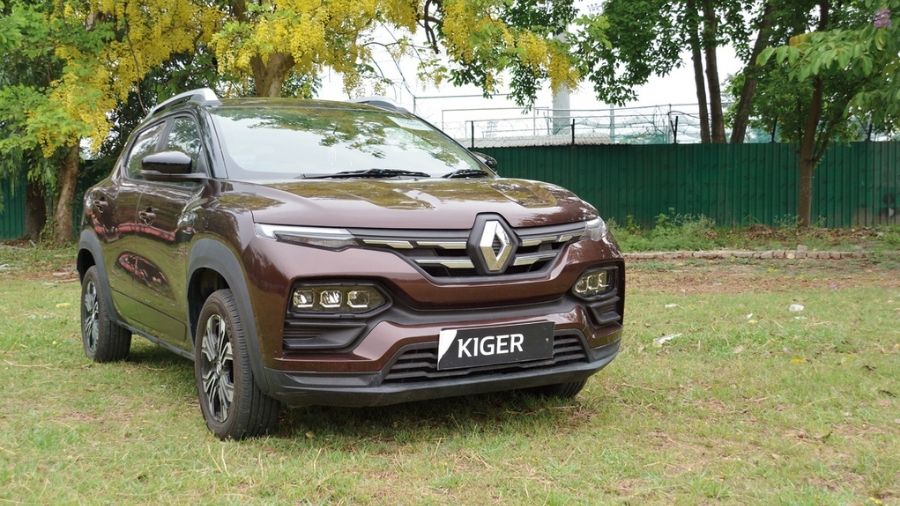This took us a while. We have been meaning to take the Renault Kiger compact SUV out for a spin since it was launched in India some time ago, but something or the other kept getting in the way. We were quite curious about this one. After all, Renault was the company that virtually created this category of compact SUVs way back when it rolled out the Duster, but it wasn’t built to take advantage of Indian tax laws. The Kiger is the first compact SUV from the company that squeezes in under the four-metre-mark and attracts lower taxes. Another reason for our curiosity about it is that it is also the least expensive compact SUV in the market, starting at Rs 5.45 lakh for the base model. We borrowed two top RXZ versions, one with the Energy engine and Easy-R AMT box, the other a Turbo with a manual to get a feel of this SUV.
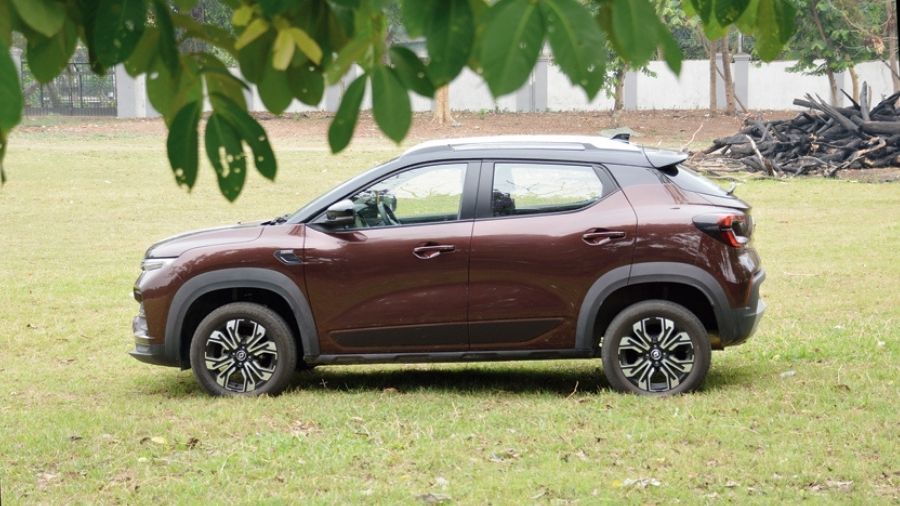
Picture by Abhijit Mitra
THE EXTERIORS
First impressions are always important and the Kiger manages to nail the SUV look. It is a handsome vehicle that comes across as broad-shouldered and muscular. The shape of the bonnet with the bulge highlighted by lower contours on either side is reminiscent of bonnet bulges of cars with big engines. The fenders have prominent cladding and play up the very smartly-styled two-tone alloys very well.
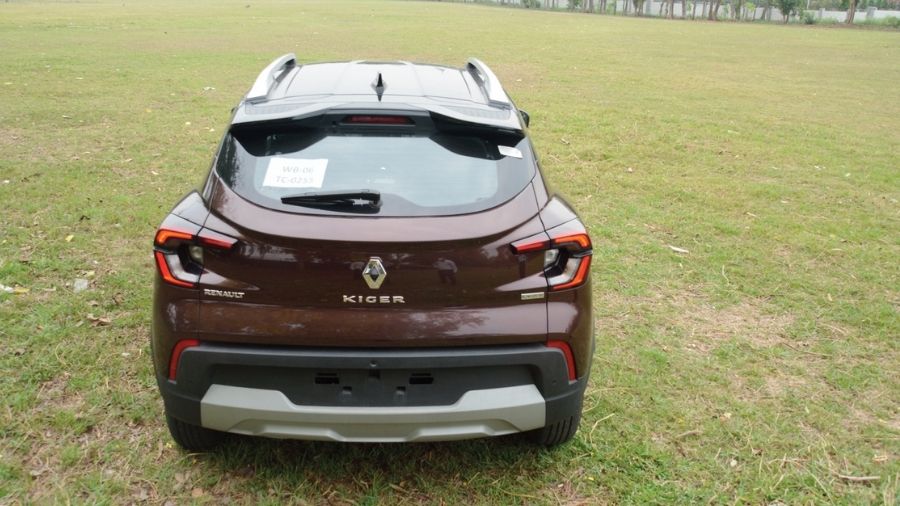
The highlight of the rear view are the C-shaped tail lamp clusters that have been given a raised design and are quite attractive. Picture by Abhijit Mitra
The wheels actually are rather nicely designed, being stylish but not over the top.
The winged grille with the straight DRLs in the slit-like wings with triple LED headlamp clusters in the lower part of the two-part front intake stand out and draw the eyes. What we liked about this SUV is that it is nicely understated. The front grille has just enough chrome bits to prevent it from looking blah — the big Renault logo is prominently shown off too.
In profile, the two-tone finish looks good with the paint line kicking up on the C-pillar just before the very sharply raked rear windscreen that gives an impression of sportiness. The shoulder line is quite high too. The highlight of the rear view are the C-shaped tail lamp clusters that have been given a raised design and are quite attractive. Adding to the impression that this is fun drive are the spats above the rear windscreen and the faux skid plates.
THE INTERIORS
The restraint in design that is visible on the outside continues inside as well. It is predominantly grey and black with parts in chrome finish and polished black breaking the monotony. What is interesting is that bits like the door opening lever, which are most often seen in silver or chrome finish, have been done in black. The design of the dash is simple with a textured bar-like section going right across that gives a sense of width.
The seats up front are well bolstered and comfortable places to be. The driving position is more car-like, but there is a driver’s seat height adjuster should someone want to sit higher up. The ones at the back, too, are comfortable. Both leg room and head room front and back are generous and should be good enough for longer journeys as well. There’s an arm rest too for rear seat passengers. The rising shoulder line makes the rear windows a tad small.
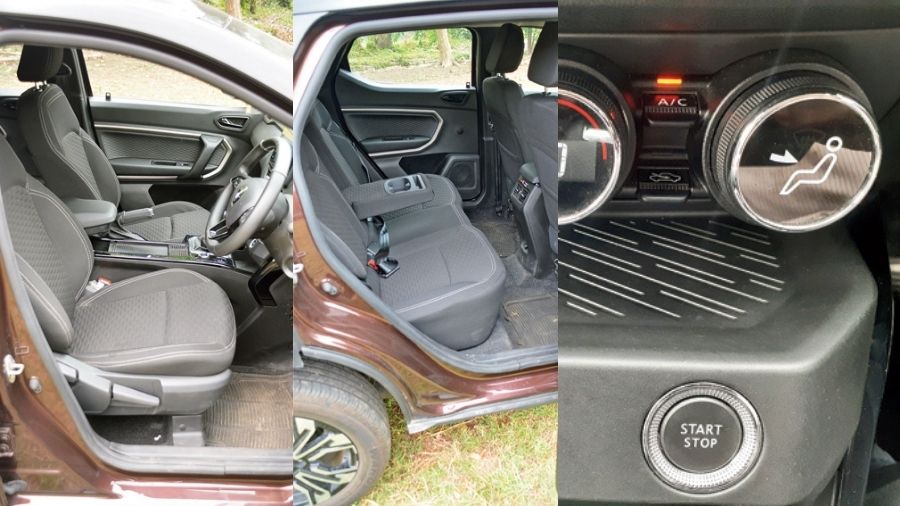
The interior design is understated in grey and bits of chrome; The central section of the dash is reminiscent of the Triber, with which the Kiger shares its platform. We liked the climate control switches with integrated displays. Picture by Abhijit Mitra

The seats are spacious and comfortable both front and back with the front ones having good bolstering and the driver getting a height adjuster as well. Picture by Abhijit Mitra
Storage spaces abound. There are spacious door pockets, a double glove box with a capacity of about 15litres, a biggish space in the centre console. There are charging ports front and back and an USB port as well. A wireless mobile charger can be had as an accessory and the aircon has a PM2.5 filter as well. The audio system is competent as well.
The driver focus of the design is obvious. It is ergonomically good with everything falling to hand easily. The wheel is nice to hold. The interior trim materials are mostly hard plastic, but look like they would hold up well enough.
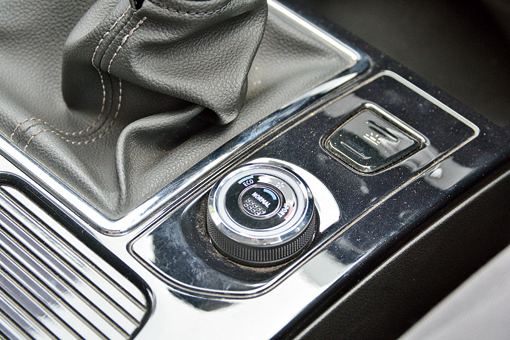
The company is offering a wireless charger as an accessory. Picture by Abhijit Mitra.
THE POWERTRAIN
The Kiger has the option of two one-litre petrol engines. There is the naturally aspirated Energy version that delivers 72ps of power and 96Nm of torque, paired either with a manual or an AMT transmission. Then there is a Turbo version as well that puts out 100ps and 160Nm (152Nm with CVT).
The Turbo is expectedly the punchier of the two with power delivery happening in a very linear way and with no palpable lag at all for all practical purposes. The Energy version, while substantially lower on power output, works well enough with the Easy-R AMT (automated manual transmission) version that we drove.
Transmission options are a five-speed manual, an Easy-R AMT and a CVT, which Renault calls the X-Tronic. We did not experience the last one, but the other two are quite good. The AMT has almost done away with the hesitation that used to be typical of these boxes. It works better when the revs are slightly higher. The manual box is quite good with longish throws but a sanguineness with which the lever slots in.
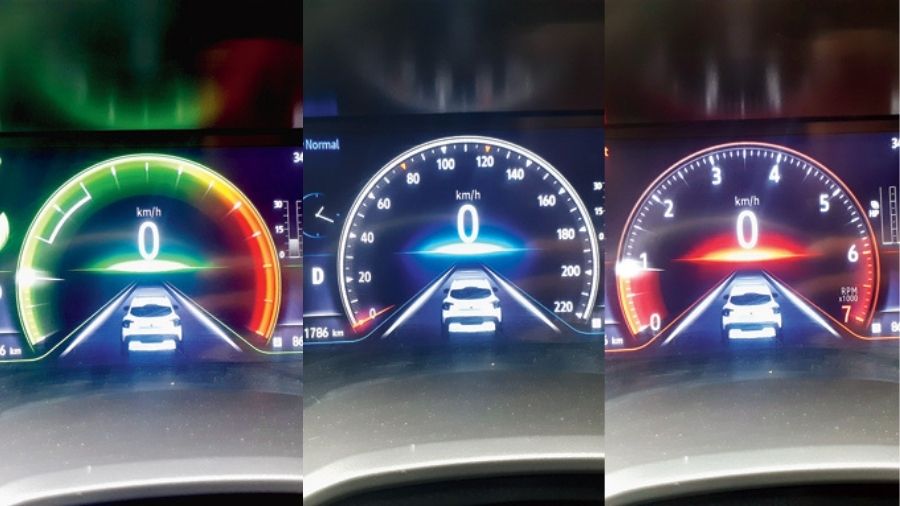
There is a drive mode selector that lets you choose among, in rising order of throttle response urgency, Eco, Normal and Sport modes. The instrument cluster display changes with driving modes. While Eco has the indicators for stretching the litre, Sport shows things like G forces on the SUV, and the proportion of power and torque being used, things spirited drivers would possibly want to know. Picture by Abhijit Mitra
There is a drive mode selector that lets the driver choose between Eco, Normal and Sport modes. These essentially seem to work on the throttle response and in case of the AMT the gear upshifts and downshifts. Eco is probably good for cruising but in the city the Normal mode is quite convenient to drive in. Sport sharpens the responses somewhat, upshifting near peak torque. With the manual, the Sport mode makes it very responsive indeed.
THE RIDE
On the road, the Kiger is composed. The suspension is a shade on the stiffer side, which lets broken bits, particularly the ridge-like ones, seep through to the passengers, more so when the speed is slow. The ride gets better as speeds pick up and it soaks up the imperfections better. At higher speeds it isn’t skittish at all and tracks nice and true and shows a lot of poise. Acceleration of the Turbo is more than adequate. The peppy engine that strikes the best balance between power and noise in the mid-revs is fun to spin up and use with the manual shifter. This compact SUV can be a lot of fun if one has the inclination. We’d like to try it out once in the hilly twisties, but that will have to wait for a while I guess.
THE CALL
For its price, the Kiger delivers very well, particularly on the drive characteristics front. A couple of connectivity features are not there, but at its price point those may not expected either. The Kiger operates in a fuss-free way. There are compact SUVs galore today, but this one is a strong contender at the value stakes, and comes with a fairly high fun quotient. That makes it rather compelling indeed!
THE KIGER IN NUMBERS
Vehicle type: Compact, front wheel drive SUV
LxBxH (mm): 3,991 x 1,750 x 1,605
Wheelbase & ground clearance(mm): 2,500, 205
Engines: 999cc, 3-cylinder petrol in naturally-aspirated Energy (E) and Turbo (T) versions
Maximum power (ps@rpm): E: 72@6,250; T: 100@5,000
Maximum torque (Nm@rpm): E: 96@3,500; T: 160@2,800-3,600 or 152@2,200-4,400
Transmission: E: MT and EASY-R AMT; T: MT and X-Tronic CVT
Fuel tank capacity (litres): 40
Brakes: Front disc and rear drum
Wheels & Tyres: 16-inch two-tone alloys, 195/60 R16
Boot volume (litres): 405
Price: Rs 5.45 lakh to Rs 9.72 lakh (ex-showroom in Calcutta)

